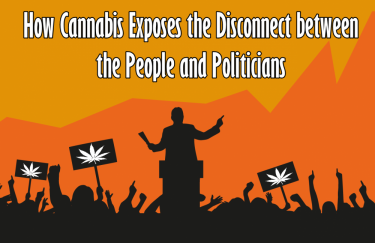
What is the divide between cannabis companies and the end user?
There’s a reason why around 80-90% of the weed we buy in Canada still comes from the black market – price!
When cannabis was illegal, it was one of the cheapest drugs on the planet. In fact, in Walk Hard: The Dewey Cox Story, they make fun of how “harmless” it really is.
Of course, when it was illegal it didn’t have the sophisticated growing processes we have on the legal market today – but neither were there all of the tough regulations that add to the cost to the consumer.
But since cannabis was officially legalized, the price per gram has increased. While this trend won’t last for long – especially after the US officially enters the cannabis market – there are some new brands trying to “get the money!” From stoners.
Some may argue, “Reg – the cost of production, regulations, quality – everything matters in terms of price” and I’m right there with you – of course!
However, the increased costs are not a matter of the plant itself, but of the new industry rules that are driving up the price. For example, things like the inability to grow outside force companies to grow inside.
Indoor growing has a large carbon footprint and increased production costs. Sure, it gives you fantastic weeds – but a greenhouse could produce the same results as any indoor grow (if not better) while drastically reducing operating costs.
Namely in air conditioning and lights.
But everything I mention relates to the “immovable” objects. By immobile, I am referring to things that the cannabis companies themselves cannot change, whether they want to or not. For example, if a particular state has rules that all cannabis plants must be tested before being sold, a legal entity cannot circumvent this.
Legal weed is just more expensive!
Because of all of the above issues, the average stoner has to accept that legal weeds are only more expensive.
That’s fine – stoners have no problem paying 15-20% more for their weeds knowing they can get high quality and easily accessible weeds with a robust product catalog.
Hell pullers would even pay up to 30% more for this.
The problem is that the average person in the United States makes about $ 900 a week, or $ 3,600 a month.
If you are making that much money then most likely you are renting your place. So let’s say that at least 25% of income is spent on renting a space – which would mean about $ 900 going to rent. Some might say, “Dude, I’ll pay $ 450,” but I’m using averages here, so don’t be a fool.
I said “average,” but that’s because average means taking the “high earners” and the “low earners” – stacking them together and then finding the median between them.
However, if you take a closer look at how many people in the US are on a minimum wage, a 2019 survey found that number was 58.1% of wage workers, or 82.3 million people in the US.
That said, they make a whopping $ 7.25 an hour. This is roughly between $ 58 and $ 72 per day. For a six-day work week, we’re talking about $ 350 to $ 432 a week. You see, roughly half the average earnings of the entire population.
Now the rent of $ 450 / month or even $ 350 / month looks steep.
Why is it important to understand the situation of 82 million Americans?
The reason I’m writing this article is to illustrate the divide between cannabis companies and a significant segment of the US population.
These “workers” take in a flat rate from cannabis users. In fact, this demographic has some of the heavier consumers in it.
And when you’re sitting between $ 1500-2000 a month with the increased cost of living, a $ 20 joint isn’t cheap!
However, you often see pharmacies and companies trying to sell “premium cannabis” that sells joints and blunts for $ 100 a pop. Even the price of premium pre-rolls or raw tenons can go up quickly.
Sure, these pharmacies and companies make money and yes there are people willing to pay for it.
But these companies are also alienating a large chunk of their potential consumer market and are the reason the vast majority of weeds still come from the black market.
Why spend $ 160 an ounce when $ 90 an ounce would be enough?
What should cannabis companies do to win the cannabis game?
If you are thinking of venturing into the cannabis market, I urge you to create the Average Jane Dispensary aimed at the Average Jane and Joe’s of the world.
In these “blue collar dispensaries,” you’re not trying to sell the premium weeds that everyone is promoting on Instagram, but rather “good weeds” that do the job.
You want a weed between 8% and 15% in THC that gets you enough buzz, but not the soil you like, the hyper-elevated THC strains.
You want to have a sturdy crop, preferably a hybrid with indica traits on the buds – short, fat, and stocky. You want to have a decent cure time, but it doesn’t have to be as elaborate as that of premium varieties.
Ultimately, you want to create a “competitive weed on the black market” where the price may increase by 10-20% due to regulatory costs but is still very accessible to these workers.
Who will be the Weed Walmart?
There is currently not a single brand that has chosen one of the largest consumer groups in the cannabis space. The first company to master the art of cheap yet potent weed will win the marijuana game simply because of the sheer volume of consumers in this demographic.
If that doesn’t happen – the Blue Collar Stoner will continue to shop on the street because when it comes to breaking the law and paying for groceries – breaking the law is far cheaper … if you don’t get caught.
This year the United States will likely try to push federal legalization forward. I’m not sure if it will happen with Old Touchy Joe at the top, but then again – I’ve been surprised in the past as well.
I know Biden cares about pharma and not the “average Joe” he claims in his election pledges – so the chances are the worker will still have to buy illegally after the federal legalization – at least for a few more years.
SEPARATE THE CANNABIS, READ MORE …

HOW CANNABIS DISCOVER THE SEPARATION BETWEEN POLITICIANS AND VOTERS!

Post a comment: